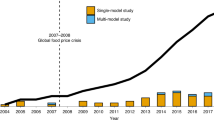Abstract
Objective: This study examined household food insecurity of urban low-income families in Korea and the associations of the food insecurity with children's dietary intake and body size.
Design: Cross-sectional study.
Setting: Low-income neighborhoods in large cities.
Subjects: Included 370 children aged 4–12 y, who had all records on dietary intake and anthropometry as well as household food insecurity measures.
Results: Using the 10-item Radimer/Cornell Scale, 62.7% of the households showed some degree of food insecurity (8.6% for food insecure for family, 28.4% for food insecure for adults and 25.7% for child hunger households). Food insecurity was linearly and negatively associated with household economic conditions as well as the caretaker's use of nutrition knowledge. There were also significant associations of food insecurity with the children's dietary intakes, indicating the largest amount of nutrients for the children from the household food insecure, followed by those from the food secure, adult food insecure and child hunger groups. The household food insecure children were fatter than the food secure children. The fatter condition of the former children appeared to be related to more frequent intakes of low-quality foods.
Conclusion: This study reports curvilinear associations between the status of household food insecurity and children's food intakes and fatness.
Sponsorship: This work was funded by a grant of the 2001 Korea Health Promotion Research Program, the Ministry of Health & Welfare, Republic of Korea.
This is a preview of subscription content, access via your institution
Access options
Subscribe to this journal
Receive 12 print issues and online access
$259.00 per year
only $21.58 per issue
Buy this article
- Purchase on Springer Link
- Instant access to full article PDF
Prices may be subject to local taxes which are calculated during checkout
Similar content being viewed by others
References
Alaimo K, Olson CM & Frongillo EA (2001): Food insufficiency and American school-aged children's cognitive, academic, and psychological development. Pediatrics 108, 44–53.
Bickel G, Nord M, Price C & Cook J (2000): Guide to measuring household food security, revised 2000. USDA Food and Nutrition Service (FNS), Office of Analysis, Nutrition, and Evaluation. URL:〈http://www.fns.usda.gov/oane〉.
Campbell C (1991): Food insecurity: a nutritional outcome or a predictor variable? J. Nutr. 121, 408–415.
Cody RP & Smith JK (1997): Applied Statistics and SAS Programming Language, 4th edition, New York: Prentice-Hall.
Department of Basic livelihood Welfare, Ministry of Health and Welfare (2000): 2000 Livelihood protection services. Republic of Korea: Ministry of Health and Welfare.
Health and welfare Bureau, Seoul metropolitan government (2001): Distribution of recipients from the National Basic Livelihood Security Program. Seoul: Seoul metropolitan government.
Himmelgreen DA, Pérez-Escamilla Rm Secura-Millan S, Peng Y-K, Gonzalez A, Singer M & Ferris A (2000): Food insecurity among low-income Hispanics in Hartford, Connecticut—implications for public health policy. Hum. Organ 59, 334–342.
Kaiser LL, Melgar-Quinonez HR, Lamp CL, Johns MC, Sutherlin JM & Harwood JO (2002): Food security and nutritional outcomes of preschool-age Mexican-American children. J. Am. Diet. Assoc. 102, 924–929.
Kendall A, Olson CM & Frongillo EA (1996): Relationship of hunger and food insecurity to food availability and consumption. J. Am. Diet. Assoc. 96, 1019–1024.
Korean Nutrition Society (2001): Food Composition Tables in Recommended Dietary Allowances for Koreans, 7th edition. Seoul: Joong-Ang Moon-Wha Publishing Co.
Korean Pediatric Society (1999): 1998 Korean Physical Growth Standards for Children and Adolescents. Seoul: Guang Mun Publishing Co.
Koo IH (2001): Socioeconomic characteristics of poverty: after the economic crisis. Proceedings of the Congress of the Korean Social Security Association. ( 2001 12. 8).
Lim Y & Oh S-Y (2002): Development of a semi-quantitative food frequency questionnaire for preschool children in Korea. Korean J. Comm. Nutr. 7, 58–66.
Live Sciences Research Organization (1990): Core indicators of nutritional status for difficult-to-sample populations. J. Nutr. 120 (Suppl), 1559–1600.
Matheson DM, Varady J, Varady A & Killen JD (2002): Household food security and nutritional status of Hispanic children in the fifth grade. Am. J. Clin. Nutr. 76, 210–217.
Ministry of Education & Human Resources Development (2001): Problems and development plan for supply and demand of school lunch. Republic of Korea: Ministry of Education & Human Resources Development.
Nam SY & Kim SH (2002): Comparison of meal management attitudes among housewives between in industrial complex and in non-industrial complex of Ansan cit in Korea. Korean J. Home Econ. 40, 167–178.
Pérez-Escamilla R, Ferris AM, Drake L, Haldemam L, Peranick J, Campbell M, Peng Y-K, Burke G & Bernstein B (2000): Food stamps are associated with food security and dietary intake of inner-city preschoolers from Hartford, Connecticut. J. Nutr. 130, 2711–2717.
Radimer KL, Olson CM, Greene JC, Campbell CC & Habicht JP (1992): Understanding hunger and developing indicators to assess it in women and children. J. Nutr. Educ. 24 (Suppl), 36S–45S.
Sarlio-Lahteenkorva S & Lahelma E (2001): Food insecurity is associated with past and present economic disadvantage and body mass index. J. Nutr. 131, 2880–2884.
Studdert LJ, Frongello EA & Valois P (2001): Household food insecurity was prevalent in Java during Indonesia's economic crisis. J. Nutr. 131, 2685–2691.
World Health Organization (1995): Physical status: the use and interpretation of anthropometry. Geneva, Switzerland: World Health Organization.
Author information
Authors and Affiliations
Corresponding author
Rights and permissions
About this article
Cite this article
Oh, SY., Hong, M. Food insecurity is associated with dietary intake and body size of Korean children from low-income families in urban areas. Eur J Clin Nutr 57, 1598–1604 (2003). https://doi.org/10.1038/sj.ejcn.1601877
Received:
Revised:
Accepted:
Published:
Issue Date:
DOI: https://doi.org/10.1038/sj.ejcn.1601877
Keywords
This article is cited by
-
Prevalence and associated factors influencing stunting in children aged 2–5 years in the Gaza Strip-Palestine: a cross-sectional study
BMC Pediatrics (2017)
-
Food Insecurity, Depression, and Social Support in HIV-Infected Hispanic Individuals
Journal of Immigrant and Minority Health (2015)
-
Obesity and household food insecurity: evidence from a sample of rural households in Malaysia
European Journal of Clinical Nutrition (2005)



